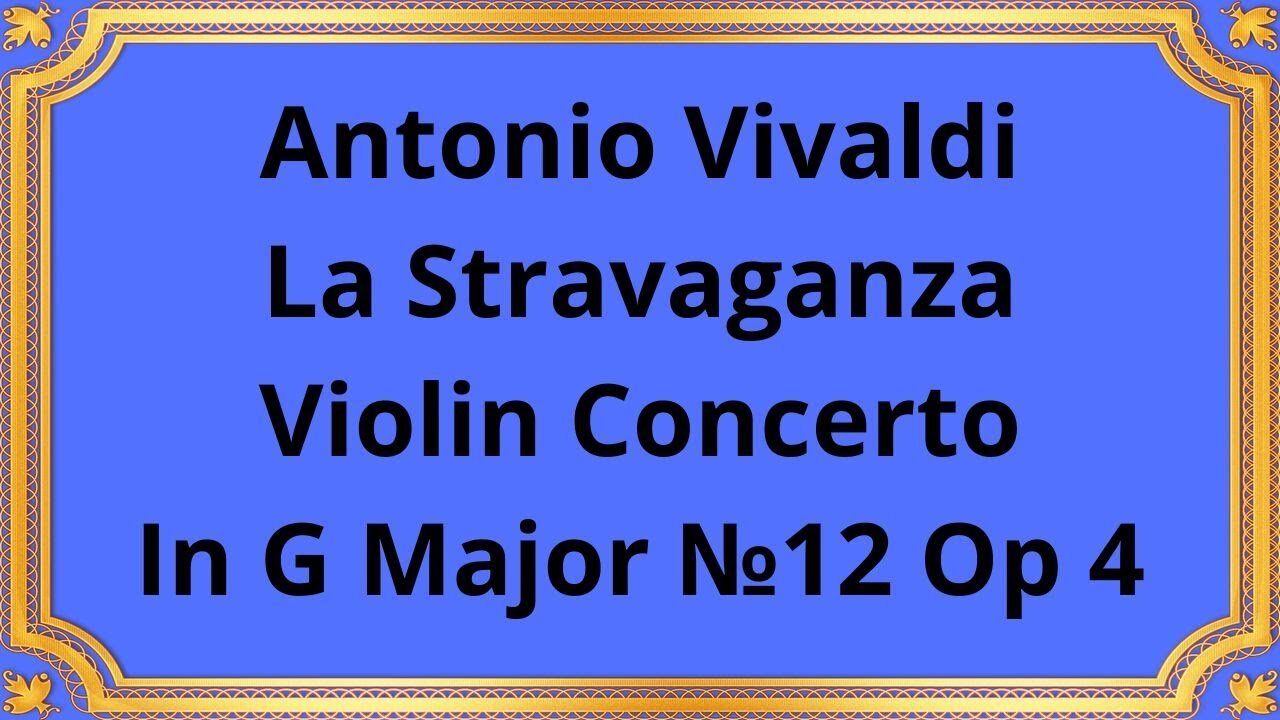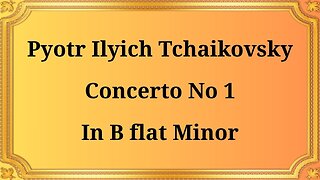Premium Only Content

Antonio Vivaldi The Stravaganza Violin Concerto In G Major №12 Op 4
#classicalmusic #Vivaldi #Stravaganza #ViolinConcerto #GMajor #Op4 #musiccomposition #baroquemusic #classicalcomposers #concertomusic #orchestralmusic
Antonio Vivaldi; Reinhold Barchet; Helma Elsner; Pro Musica Orchestra Stuttgart; Rolf Reinhardt
Antonio Vivaldi, one of the most influential composers of the Baroque era, left an indelible mark on the world of classical music. Among his vast repertoire, the Stravaganza Violin Concerto in G Major, No. 12, Op. 4 stands out as a masterpiece that showcases Vivaldi's exceptional talent and innovative approach to composition.
Antonio Vivaldi composed the Stravaganza Violin Concerto in G Major, No. 12, Op. 4 in the early 18th century. This period, known as the Baroque era, was characterized by elaborate ornamentation, rich harmonies, and virtuosic performances. Vivaldi's contribution to the development of the concerto form was immense, and this particular concerto exemplifies his mastery.
The Stravaganza Violin Concerto in G Major, No. 12, Op. 4 follows the typical three-movement structure of a concerto: fast-slow-fast. The first movement, marked Allegro, is a lively and energetic display of Vivaldi's compositional prowess. It features a virtuosic solo violin part, accompanied by a string orchestra. The second movement, marked Largo, provides a moment of introspection and tranquility, with the solo violin weaving a melodic tapestry accompanied by delicate harmonies. The final movement, marked Allegro, returns to the vibrant and spirited nature of the opening, with the solo violin leading the charge and engaging in playful dialogues with the orchestra.
What sets the Stravaganza Violin Concerto in G Major, No. 12, Op. 4 apart from other concertos of the time is Vivaldi's ingenious use of thematic material and his ability to create vivid musical imagery. The opening Allegro movement displays Vivaldi's trademark virtuosity, with rapid passages, intricate ornamentation, and brilliant melodic lines. The Largo movement, in contrast, showcases Vivaldi's lyrical sensibility, with long, expressive phrases and tender melodies. The final Allegro movement is characterized by rhythmic drive and energetic interplay between the soloist and the orchestra, creating a sense of exhilaration and joy.
The Stravaganza Violin Concerto in G Major, No. 12, Op. 4 stands as a testament to Vivaldi's innovation and mastery of the concerto genre. Its popularity has endured over the centuries, captivating audiences with its technical brilliance and emotional depth. Vivaldi's influence on future generations of composers cannot be overstated, as his innovative use of form, harmony, and virtuosic writing paved the way for the development of classical music as we know it today.
Conclusion:
Antonio Vivaldi's Stravaganza Violin Concerto in G Major, No. 12, Op. 4 is a remarkable musical composition that exemplifies the genius of this iconic Baroque composer. Its three-movement structure, virtuosic solo violin part, and expressive melodies continue to captivate audiences and inspire musicians around the world. By exploring the historical context, musical structure, and enduring legacy of this concerto, we gain a deeper appreciation for Vivaldi's contributions to the world of classical music and the timeless beauty of his compositions.
You have the opportunity to support the channel:
https://destream.net/live/RadSiarAl/donate
https://www.buymeacoffee.com/6355radsiaral
-
 31:06
31:06
Classical music_Music Inspiration
1 month agoPyotr Ilyich Tchaikovsky Piano Concerto No. 1 in B-flat minor
581 -
 2:02:27
2:02:27
Redacted News
2 hours ago"This is an ACT OF WAR!" Israel Bombs Qatar - Middle East Descending into Chaos | Redacted
67.1K80 -
 53:14
53:14
Candace Show Podcast
2 hours agoBecoming Brigitte: The God Of Amiens.
22.6K50 -
 LIVE
LIVE
MattMorseTV
2 hours ago $3.40 earned🔴Trump’s Oval Office PROCLAMATION. 🔴
1,115 watching -
 0:31
0:31
Danny Rayes
1 day agoThis Company is Cooked 😨
43 -
 LIVE
LIVE
Wayne Allyn Root | WAR Zone
5 hours agoWAR Zone LIVE | 9 SEPTEMBER 2025
96 watching -
 1:14:54
1:14:54
vivafrei
3 hours agoCash for Criminals? Did Judge Wrongly Release Accused Murderer? Epstein Doc Release! Swalwell Sucks!
72.3K22 -
 2:02:47
2:02:47
The Quartering
5 hours agoToday's Breaking News! Greta FAKES Drone Attack, Animal Cruelty Spike & Cracker Barrel
92.4K33 -
 1:15:17
1:15:17
Awaken With JP
5 hours agoKaren Strikes Again, There is No Crime, Communism Succeeds! - LIES Ep 107
39.2K20 -
 39:11
39:11
Stephen Gardner
2 hours ago🔥Trump TAKES ACTION as Democrats ABANDON Party!
19.1K16